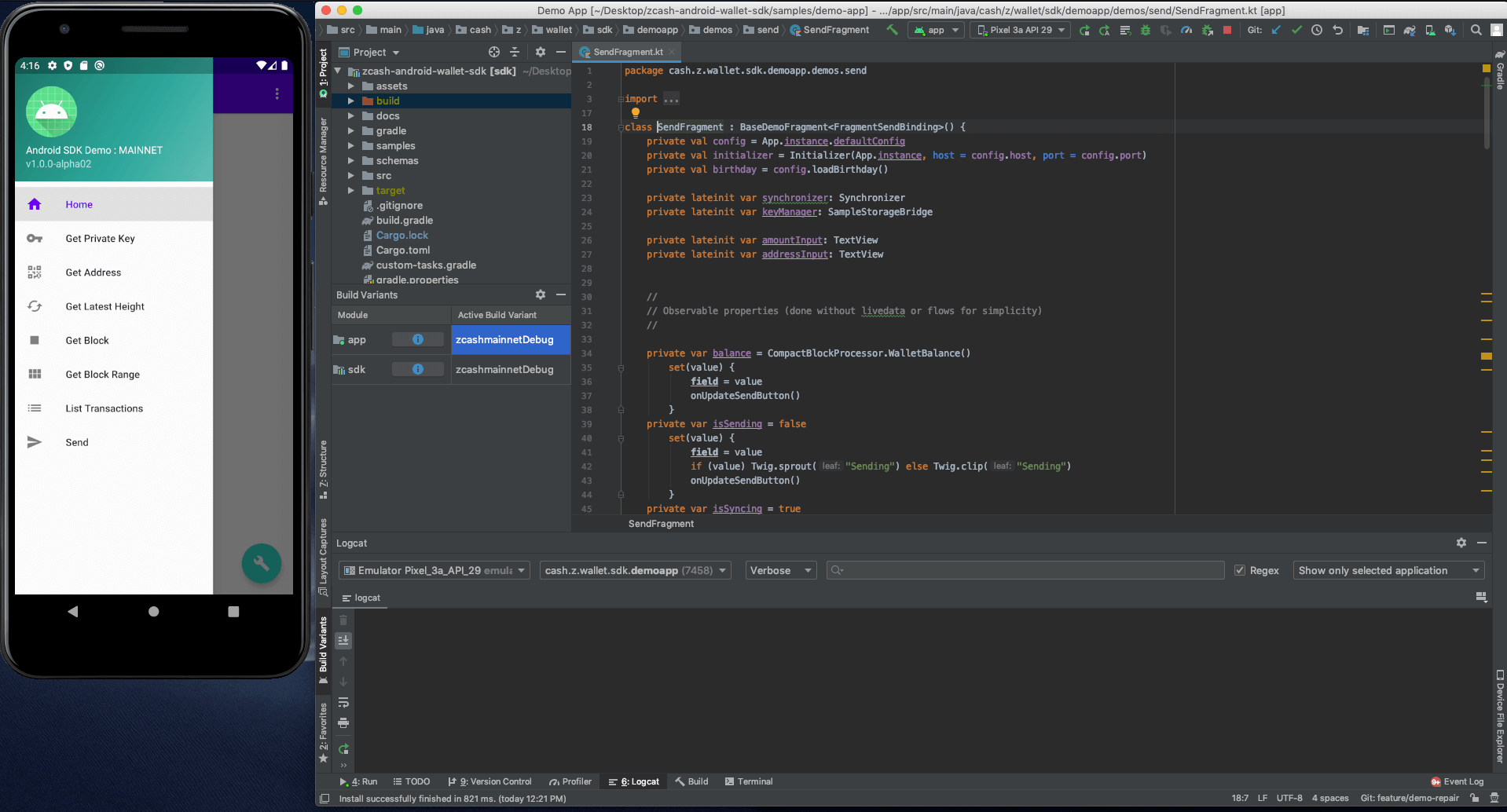|
|
1 year ago | |
|---|---|---|
| .. | ||
| assets | 2 years ago | |
| src | 1 year ago | |
| README.md | 2 years ago | |
| build.gradle.kts | 2 years ago | |
| lint-baseline.xml | 2 years ago | |
| proguard-project.txt | 2 years ago | |
README.md
Android demo app
This is a demo app that exercises code in https://github.com/zcash/zcash-android-wallet-sdk, which has all the Android-related functionalities necessary to build a mobile Zcash shielded wallet.
It relies on Lightwalletd, a backend service that provides a bandwidth-efficient interface to the Zcash blockchain. There is an equivalent iOS demo app.
Contents
Requirements
The demo app is built in Kotlin, and targets API 21. The demo pulls the pre-built SDK from jcenter so, unlike the SDK, it does not require Rust or the NDK!
Installation
In short, you simply will need to:
- (pre-requisite) Install Android Studio and setup an emulator or device
- Clone this repo: https://github.com/zcash/zcash-android-wallet-sdk
- Open the
demo-appfolder in Android Studio and launch the app
(recommended build variant:zcashmainnetDebug)
Exploring the demo app
After building the app, the emulator should launch with a basic app that exercises the SDK (see picture below). To explore the app, click on each menu item, in order, and also look at the associated code.
The demo app is not trying to show what's possible, but to present how to accomplish the building blocks of wallet functionality in a simple way in code. It is comprised of the following self-contained demos. All data is reset between demos in order to keep the behavior repeatable and independent of state.
Demos
| Menu Item | Related Code | Description |
|---|---|---|
| Get Private Key | GetPrivateKeyFragment.kt | Given a seed, display its viewing key and spending key |
| Get Address | GetAddressFragment.kt | Given a seed, display its z-addr |
| Get Balance | GetBalanceFragment.kt | Display the balance |
| Get Latest Height | GetLatestHeightFragment.kt | Given a lightwalletd server, retrieve the latest block height |
| Get Block | GetBlockFragment.kt | Given a lightwalletd server, retrieve a compact block |
| Get Block Range | GetBlockRangeFragment.kt | Given a lightwalletd server, retrieve a range of compact blocks |
| List Transactions | ListTransactionsFragment.kt | Given a seed, list all related shielded transactions |
| Send | SendFragment.kt | Send and monitor a transaction, the most complex demo |
Getting started
We’re assuming you already have a brilliant app idea, a vision for the app’s UI, and know the ins and outs of the Android lifecycle. We’ll just stick to the Zcash app part of “getting started.”
Similarly, the best way to build a functioning Zcash shielded app is to implement the functionalities that are listed in the demo app, in roughly that order:
- Generate and safely store your private key.
- Get the associated address, and display it to the user on a receive screen. You may also want to generate a QR code from this address.
- Make sure your app can talk to the lightwalletd server and check by asking for the latest height, and verify that it’s current with the Zcash network.
- Try interacting with lightwalletd by fetching a block and processing it. Then try fetching a range of blocks, which is much more efficient.
- Now that you have the blocks process them and list transactions that send to or are from that wallet, to calculate your balance.
- With a current balance (and funds, of course), send a transaction and monitor its transaction status and update the UI with the results.
Resources
You don’t need to do it all on your own.
- Chat with the wallet team: Zcash discord community channel, wallet
- Discuss ideas with other community members: Zcash forum
- Get funded to build a Zcash app: Zcash foundation grants program
- Follow Zcash-specific best practices: Zcash wallet developer checklist
- Get more information and see FAQs about the wallet: Shielded resources documentation
